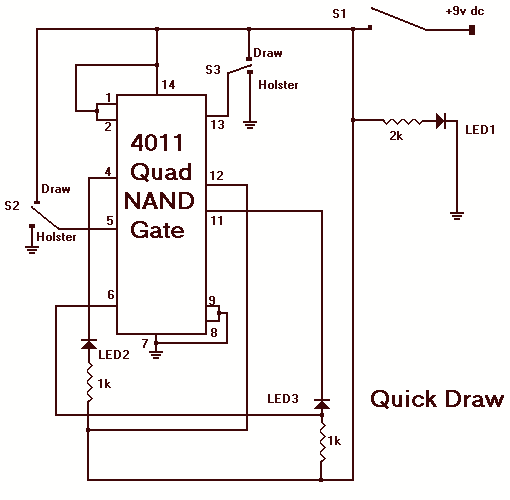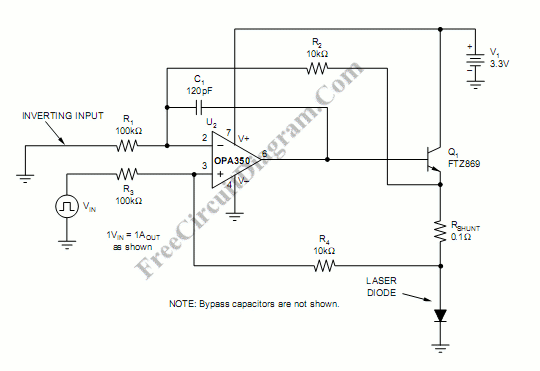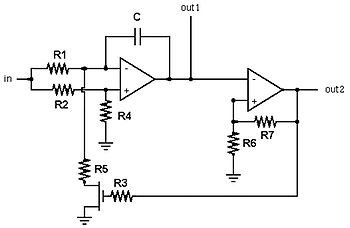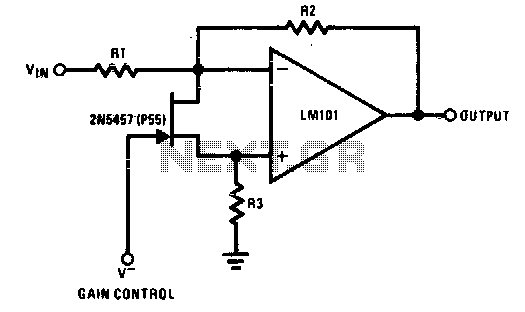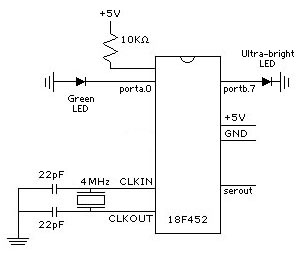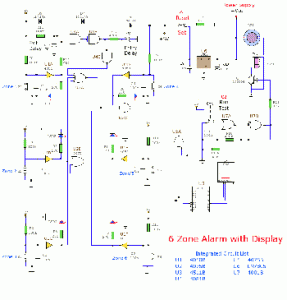
1W LED Driver
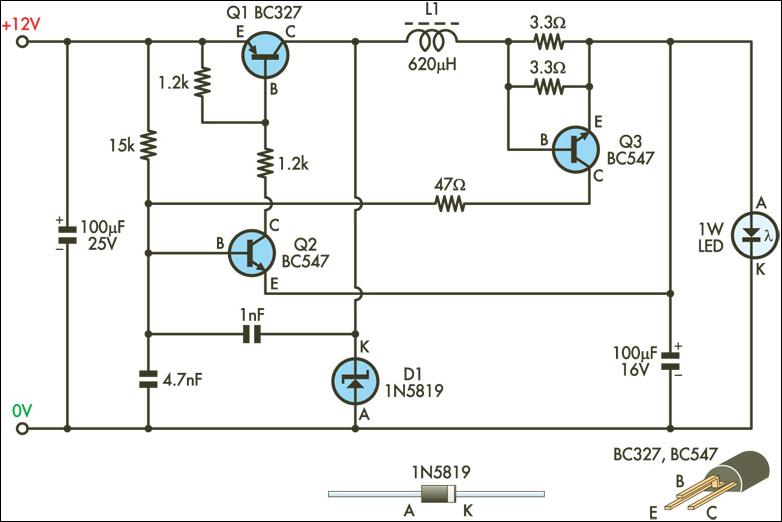
This circuit is designed to drive 1W LEDs that are commonly available. Their non-linear voltage to current relationship and variation in forward voltage with temperature necessitate the use of a 350mA constant-current power source as provided by this supply. In many respects, the circuit operates like a conventional step-down (buck) switching regulator. Transistor Q1 is the switching element, while inductor L1, diode D1, and the 100µF capacitor at the output form the energy transfer and storage elements. The pass transistor (Q1) is switched by Q2, which, along with the components in its base circuit, forms a simple oscillator. A 1nF capacitor provides the positive feedback necessary for oscillation. The output current is sensed by transistor Q3 and the two parallel resistors in its base-emitter circuit. When the current reaches about 350mA, the voltage drop across the resistors exceeds the base-emitter forward voltage of transistor Q3 (approximately 0.6V), switching it on. Q3's collector then pulls Q2's base towards ground, switching it off, which in turn switches off the main pass transistor (Q1). The time constant of the 15kΩ resistor and 4.7nF capacitor connected to Q2's base adds hysteresis to the loop, thus ensuring regulation of the set output current. The inductor was made from a small toroid salvaged from an old computer power supply and rewound with 75 turns of 0.25mm enamelled copper wire, giving an inductance of about 620mH. The output current level should be trimmed before connecting the 1W LED. To do this, wire a 10Ω 5W resistor across the output as a load and adjust the value of one or both of the resistors in the base-emitter circuit of Q3 to achieve 3.5V (maximum) across the load resistor.
This circuit is an efficient solution for driving 1W LEDs, which require a stable current source due to their unique electrical characteristics. The design functions as a buck converter, utilizing Q1 as the primary switching transistor to regulate the output current. The inductor L1 plays a critical role in energy storage, while diode D1 ensures current flows in the correct direction to the output capacitor, smoothing the output voltage.
The oscillator formed by Q2 and its base circuit is essential for controlling the switching frequency of Q1. The inclusion of a 1nF capacitor for positive feedback is a key feature that enables the oscillation process, allowing for rapid switching and efficient energy transfer. The sensing mechanism implemented through Q3 ensures that the output current remains at the desired level of 350mA. As the output current increases, the voltage across the base-emitter resistors of Q3 rises, leading to its activation and the subsequent shutdown of Q2, thereby regulating the current flowing through Q1.
The hysteresis introduced by the resistor-capacitor combination connected to Q2's base enhances the stability of the current regulation, preventing rapid oscillations and ensuring a smooth output. The use of a salvaged toroidal inductor demonstrates an efficient approach to component selection, optimizing the circuit's performance.
Prior to connecting the 1W LED, it is crucial to adjust the output current. This can be achieved by temporarily connecting a 10Ω 5W load resistor and fine-tuning the base-emitter resistors of Q3 to attain the specified voltage across the load, ensuring safe operation of the LED once connected. This meticulous attention to detail in the circuit design and setup process is vital for optimal performance and longevity of the LEDs.This circuit is designed to drive the 1W LEDs that are now commonly available. Their non-linear voltage to current relationship and variation in forward voltage with temperature necessitates the use of a 350mA, constant-current power source as provided by this supply. In many respects, the circuit operates like a conventional step-down (buck) swit ching regulator. Transistor Q1 is the switching element, while inductor L1, diode D1 and the 100mF capacitor at the output form the energy transfer and storage elements. The pass transistor (Q1) is switch-ed by Q2, which together with the components in its base circuit, forms a simple oscillator.
A 1nF capacitor provides the positive feedback necessary for oscillation. The output current is sensed by transistor Q3 and the two parallelled resistors in its base-emitter circuit. When the current reaches about 350mA, the voltage drop across the resistors exceeds the base-emitter forward voltage of transistor Q3 (about 0.
6V), switching it on. Q3`s collector then pulls Q2`s base towards ground, switching it off, which in turn switches off the main pass transistor (Q1). The time constant of the 15kW resistor and 4. 7nF capacitor connected to Q2`s base adds hysteresis to the loop, thus ensuring regulation of the set output current.
The inductor was made from a small toroid salvaged from an old computer power supply and rewound with 75 turns of 0. 25mm enamelled copper wire, giving an inductance of about 620mH. The output current level should be trimmed before connecting your 1W LED. To do this, wire a 10W 5W resistor across the output as a load and adjust the value of one or both of the resistors in the base-emitter circuit of Q3 to get 3.
5V (maximum) across the load resistor. 🔗 External reference
This circuit is an efficient solution for driving 1W LEDs, which require a stable current source due to their unique electrical characteristics. The design functions as a buck converter, utilizing Q1 as the primary switching transistor to regulate the output current. The inductor L1 plays a critical role in energy storage, while diode D1 ensures current flows in the correct direction to the output capacitor, smoothing the output voltage.
The oscillator formed by Q2 and its base circuit is essential for controlling the switching frequency of Q1. The inclusion of a 1nF capacitor for positive feedback is a key feature that enables the oscillation process, allowing for rapid switching and efficient energy transfer. The sensing mechanism implemented through Q3 ensures that the output current remains at the desired level of 350mA. As the output current increases, the voltage across the base-emitter resistors of Q3 rises, leading to its activation and the subsequent shutdown of Q2, thereby regulating the current flowing through Q1.
The hysteresis introduced by the resistor-capacitor combination connected to Q2's base enhances the stability of the current regulation, preventing rapid oscillations and ensuring a smooth output. The use of a salvaged toroidal inductor demonstrates an efficient approach to component selection, optimizing the circuit's performance.
Prior to connecting the 1W LED, it is crucial to adjust the output current. This can be achieved by temporarily connecting a 10Ω 5W load resistor and fine-tuning the base-emitter resistors of Q3 to attain the specified voltage across the load, ensuring safe operation of the LED once connected. This meticulous attention to detail in the circuit design and setup process is vital for optimal performance and longevity of the LEDs.This circuit is designed to drive the 1W LEDs that are now commonly available. Their non-linear voltage to current relationship and variation in forward voltage with temperature necessitates the use of a 350mA, constant-current power source as provided by this supply. In many respects, the circuit operates like a conventional step-down (buck) swit ching regulator. Transistor Q1 is the switching element, while inductor L1, diode D1 and the 100mF capacitor at the output form the energy transfer and storage elements. The pass transistor (Q1) is switch-ed by Q2, which together with the components in its base circuit, forms a simple oscillator.
A 1nF capacitor provides the positive feedback necessary for oscillation. The output current is sensed by transistor Q3 and the two parallelled resistors in its base-emitter circuit. When the current reaches about 350mA, the voltage drop across the resistors exceeds the base-emitter forward voltage of transistor Q3 (about 0.
6V), switching it on. Q3`s collector then pulls Q2`s base towards ground, switching it off, which in turn switches off the main pass transistor (Q1). The time constant of the 15kW resistor and 4. 7nF capacitor connected to Q2`s base adds hysteresis to the loop, thus ensuring regulation of the set output current.
The inductor was made from a small toroid salvaged from an old computer power supply and rewound with 75 turns of 0. 25mm enamelled copper wire, giving an inductance of about 620mH. The output current level should be trimmed before connecting your 1W LED. To do this, wire a 10W 5W resistor across the output as a load and adjust the value of one or both of the resistors in the base-emitter circuit of Q3 to get 3.
5V (maximum) across the load resistor. 🔗 External reference
